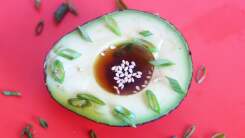A frozen cut of meat on a rustic wood table
Buying meat when it’s on sale and then freezing it for when you need it is great...in theory. In practice, it’s difficult (some might even say impossible) to remember to thaw frozen meat ahead of time. The recommended method—thawing frozen meat overnight in the fridge—can take more than a day. It also requires planning, which, LOL. As a speedier alternative, many people submerge frozen meat in cold water. But there’s an even faster method: hot water baths.
You may have heard that using hot water to thaw frozen meat is a bad idea because the water can cook the surface of the meat or lead to bacterial growth. But research sponsored by the USDA and published in the Journal of Food Science and in Food Control in 2011 found that for thin cuts of meat—one-inch steaks, chops, and chicken breasts, which probably constitute the cuts you cook most often—thawing in hot water can be done in as little as 10 minutes without reducing the quality or safety of the meat.
Harold McGee reports in the New York Times:

At the U.S.D.A. labs in Beltsville, Md., Janet S. Eastridge and Brian C. Bowker test-thawed more than 200 one-inch-thick beef strip loin steaks in three different groups: some in a refrigerator at 37 to 40 degrees Fahrenheit, some in a constantly circulating water bath at 68 degrees, and some in a water bath at 102 degrees.
Air-thawing in the refrigerator took 18 to 20 hours, while the room-temperature water bath thawed the steaks in about 20 minutes, and the hot-summer-day bath in 11 minutes. These water-bath times are so short that any bacterial growth would remain within safe limits.
Not only that, but water thawing methods may result in better-tasting (or at least juicier) steaks:
The water-thawed steaks actually leaked less juice than the air-thawed steaks.
Similar results were found for chicken breasts, with one-inch cutlets thawing in 9 minutes, and half-inch breasts thawing in a little over 3 minutes. That’s pretty fast.
McGee says his method is to use 125-degree tap water and immerse plastic-wrapped meat in the large pot, stirring occasionally. Stirring is important because it prevents a cold zone from developing around the food that insulates it from the remaining warm water. As an alternative, run a steady drip of hot water into the bath. Also, you need to cook any meat you’ve defrosted immediately after thawing it in a hot water bath; there’s no refreezing.
Don’t try this with large roasts or turkeys, as those are still safest to consume when thawed in the fridge or in cold water. But for thinner cuts, this hot water bath method may save you some precious time—great news if you’re a last-minute cook.
This story was originally published in 2012 and was updated on Jan. 27, 2021 to update dead links and revise the content to align with current Lifehacker style.
RECOMMENDED NEWS

The Easiest Way to Keep Track of Your Favorite Instant Pot Cook Times
If you have an Instant Pot—or a “One Pot,” as my stepmom likes to call it—you have probably noticed ...

5 No-Peel Apple Recipes You Need to Try This Fall
Fall is upon us, which means that apple season—arguably the best season of them all—is just around t...

Pick the Tomatoes at the Bottom of Your Plant First
This is year is my first year as a gardener. I think it’s going well, especially when you consider I...

You Can Turn Any Beverage Into Cake Icing
It’s a universal law that a lovely loaf or bundt cake must be topped with a simple icing drizzle. Al...

How to Get a Rub to Stick to Your Meat
Rubs and rubbing rubs on meat are an important part of barbecuing. The mix of seasonings and spices ...

Pour Stuff Into the Avocado Hole
I have always appreciated the neatness of an avocado. Once halved, you can scoop the creamy green fl...
Comments on "A frozen cut of meat on a rustic wood table" :